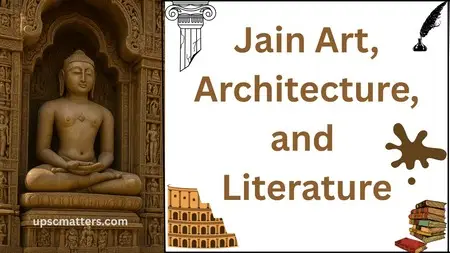Jain art and Jain architecture are among the most exquisite and spiritually significant contributions to India’s cultural heritage. Rooted in the principles of non-violence, asceticism, and inner purity, Jain artistic traditions emphasize simplicity, symbolism, and serenity. From the intricately carved marble temples of Mount Abu’s Dilwara to the towering monolithic statue at Shravanabelagola, Jain architecture reflects a pursuit of spiritual elevation through structural elegance. Similarly, Jain art—in the form of sculptures, paintings, and iconography—portrays the calm and meditative ideals of the Tirthankaras and the path to liberation. This article explores the evolution, characteristics, and legacy of Jain art and Jain architecture, highlighting their influence on Indian aesthetics and their continued relevance in the modern world.
Jain Art: Spiritual Expression Through Aesthetics
- Central Themes:
- Depiction of the 24 Tirthankaras (spiritual teachers).
- Symbols: Lion (Mahavira), Lotus, Swastika, Om.
- Tirthankara Statues
- Usually shown in Kayotsarga (standing) or Padmasana (seated) posture.
- Always shown without adornment, reflecting detachment and asceticism.
- Forms of Jain Art:
- Sculptures and idols in meditative poses.
- Intricate relief work on temple walls and caves.
- Symbolic representation focused on serenity and detachment.
- Miniature Paintings:
- Flourished in Gujarat and Rajasthan (11th–16th century).
- Illustrated manuscripts like Kalpa Sūtra.
- Painted on palm leaves or handmade paper using natural dyes.
- Patronage:
- Financed largely by Jain merchant communities and kings.
- Emphasis on religious art rather than courtly or martial themes.
- Symbols in Jain Art
- Siddha Chakra, Swastika, Triratna symbol, Om, and hand with a wheel (Ahimsa) are common motifs.
Jain Architecture: Temples that Echo Silence
Rock-cut Architecture (Early Phase)
- Udayagiri and Khandagiri Caves (Odisha)
- Commissioned by King Kharavela (1st century BCE), these caves are one of the earliest Jain monastic sites.
- Notable for inscriptions and reliefs of Tirthankaras.
- Ellora Caves (Maharashtra)
- Jain caves (9th century) lie beside Buddhist and Hindu caves – highlight religious tolerance.
- Jain caves are known for precision and simplicity.
Temple Architecture (Medieval Period)
- Dilwara Temples (Mount Abu, Rajasthan)
- Built between the 11th–13th centuries by Solanki rulers, especially Vimal Shah.
- Known for marble carvings, intricate ceilings, and austere design reflecting Jain ideals.
- Shravanabelagola (Karnataka)
- Home to the 57-ft monolithic statue of Bahubali (Gommateshwara) – one of the largest freestanding statues in the world.
- Center of the Mahamastakabhisheka festival held every 12 years.
- Ranakpur Temple (Rajasthan)
- Built in the 15th century by Dharna Shah, dedicated to Tirthankara Adinatha.
- Famous for its 1444 intricately carved marble pillars – no two are alike.
- Palitana Temples (Shatrunjaya Hills, Gujarat)
- One of the holiest Jain pilgrimage sites with over 860 temples.
- Built over centuries by Jain patrons and devotees.
Architectural Features:
- Intricate carvings, floral and geometric motifs.
- Emphasis on symmetry, purity (white marble), and silence.
- Designed as spaces for meditation and inner transformation.
Jain Literature: A Treasury of Knowledge
Languages Used: Ardhamagadhi Prakrit, Sanskrit, Apabhramsha, Kannada, Tamil.
Key Texts and Scholars:
- Agamas: Canonical scriptures based on Mahavira’s teachings.
- Tattvartha Sutra: First Jain text in Sanskrit by Umāsvāti—accepted by both Digambara and Śvetāmbara sects.
- Prominent Acharyas:
- Bhadrabahu: Authored Kalpa Sūtra.
- Haribhadra: Philosopher and prolific writer.
- Hemachandra: Polymath, advisor to King Kumarpala; contributed to grammar, logic, ethics.
Themes in Literature:
- Karma, rebirth, liberation (Moksha), logic (Syadvada), and ethics.
- Emphasis on non-violence, truth, renunciation, and personal discipline.
- Played a key role in developing early Indian logic and metaphysics.
Contemporary Relevance and Global Recognition of Jain Art.
- Influence on Indian Thought:
- Inspired Mahatma Gandhi’s principle of Ahimsa.
- Helped shape India’s non-violent freedom movement.
- Global Reach:
- Jain temples and cultural centers established in the USA, UK, Kenya, etc.
- Active global Jain diaspora preserving traditions.
- Recognition:
- Jain sites like Mount Abu and Shravanabelagola under consideration for UNESCO status.
- Increasing academic and cultural interest in Jain heritage.
- Modern Ethical Relevance:
- Vegetarianism, environmental consciousness, and sustainability echo Jain principles.
- Jain values offer peaceful, sustainable solutions for modern challenges.
What are Purvas and Angas in Jain Literature?
Purvas (The Earliest Jain Scriptures)
- Meaning: “Purva” literally means “ancient”.
- Considered the earliest and oldest Jain scriptures.
- Traditionally believed to be composed before Mahavira but preserved and taught by him.
| Term | Meaning | Number | Status | Content Focus |
| Purvas | Ancient texts | 14 | Lost | Jain philosophy, karma, metaphysics |
| Angas | Canonical limbs | 12 (1 lost) | 11 available | Rules, ethics, doctrines, narratives |
Key Features of Purvas:
- Originally 14 texts – called Chaturdasha Purvas.
- Formed part of the Drishtivada – the 12th Anga, which no longer survives.
- Covered Jain metaphysics, cosmology, karma theory, etc.
- Lost over time, especially after a famine during Bhadrabahu’s time (~4th century BCE), due to oral tradition breaking down.
Angas (Canonical Jain Scriptures)
- Meaning: “Limb” or “part”.
- Considered direct teachings of Mahavira, compiled by his disciples (Ganadharas).
- Recognized mainly by the Svetambara sect.
Key Features of Angas:
- There are 11 surviving Angas (originally 12).
- The 12th Anga – Drishtivada (which included the Purvas) is considered lost.
List of Important Angas:
- Ācāranga Sūtra – Rules for monks and ethics
- Sūtrakṛtānga – Jain doctrines and refutations of rival philosophies
- Sthānānga – Classification of knowledge
- Samavāyānga – More classification with numeric schemes
- Vyākhyāprajñapti (Bhagavati Sūtra) – Mahavira’s teachings in Q&A format
- Jñātādharmakathā – Religious stories and moral teachings
- Upāsakadaśā – Conduct of lay followers
- Antakṛddaśā – Stories of souls who attained liberation
- Anuttaraupapātikadaśā – Stories of those destined for highest heavens
- Praśnavyākaraṇa – Divinatory techniques
- Vipākasūtra – Karma theory and its consequences
- Drishtivāda – LOST, included Purvas
Conclusion-
- Jain art, architecture, and literature reflect the timeless pursuit of inner peace, truth, and non-violence.
- These cultural contributions go beyond religious identity—offering universal lessons in simplicity, harmony, and ethical living.
- In a world marked by conflict and excess, the Jain way stands out as a path of balance, wisdom, and deep introspection.
To read more about Jainism- kindly click here
To read about Buddhism- kindly click here
For Comparison between Jainism Vs Buddhism Vs Vedic Civilization
If you found this helpful, you might also like these articles:
📌 [https://upscmatters.com/indus-valley-civilization/ ]
📌 [https://upscmatters.com/buddhism-a-complete-guide-for-upsc-history/]
They cover key concepts that will boost your preparation! 🚀
📢 Stay Updated with the Best UPSC Resources!
Join our Telegram Channel for:
✅ Daily Current Affairs
✅ Important Notes & PDFs
✅ Answer Writing Tips
✅ Strategy & Motivation
📲 Click the link to join now: [https://t.me/upscmatters] or [https://t.me/ramsirnotes]
Don’t miss out on valuable updates! 🚀

